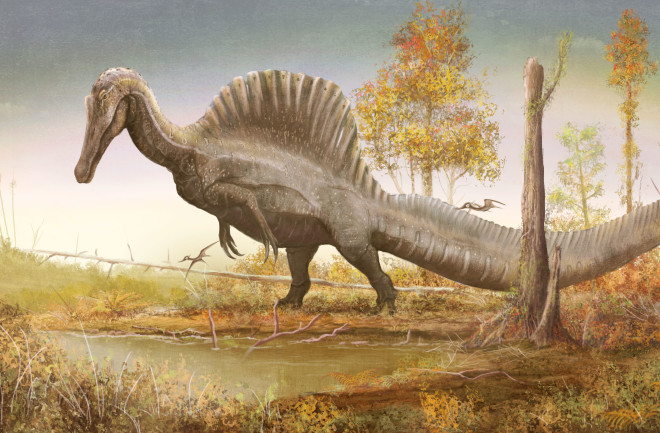What do a velociraptor, Tyrannosaurus rex and Spinosaurus all have in common?
For starters, the carnivorous trio clawed their way to superstar status as antagonists in the first three films in the Jurassic Park franchise. But on a more basic level, these dinosaurs are all theropods. Put simply, this group of dinosaurs mostly walked on two legs, had three claws on their feet, and of course, ate meat.
“Theropods are the most charismatic of the dinosaurs,” says Joseph Frederickson, museum director at the Weis Earth Science Museum. “These are the ones that would be the stereotypical monsters that we know from movies like Jurassic Park.”
What Are Theropods?
Theropod means “beast-footed,” and these carnivorous (and sometimes omnivorous) dinosaurs roamed the earth from the Late Triassic through the end of the Cretaceous —although with modern-day birds are their distant relatives, in a sense their reign never ended.
Read More: How Do Scientists Reconstruct What Dinosaurs Looked Like?
“They ranged in size from little itty-bitty things that you can hold in your hands — that would be quite cute if they weren't nipping at you — to gigantic monsters like Tyrannosaurus rex, Spinosaurus or Carcharodontosaurus,” adds Frederickson
Unique Adaptations: Microraptors and Mononykus
In addition to ranging from miniature nippers to giant terrors, theropods adapted to fill a whole range of ecological niches. One of the smaller examples are the microraptors whose name means “tiny plunderer." Weighing in at a mere one kilogram, this feathery dinosaur hunted birds, fish and lizards.
Another, curious example is Mononykus, which roamed modern day China and Mongolia during the late cretaceous period and had an adaption somewhat similar to an anteater, according to Frederickson.
“They have these strong arms that have this one claw on the end and they use it to smash into tree trunks and termite mounds,” says Frederickson.
Size Variations of Theropod Dinosaurs
Those that capture the imagination most, however, are the big meat-eaters. Spinosaurus weighed in at 7.4 tons and stretched around 45 feet, around three times the length of an African elephant.
"Spinosaurus is probably the only aquatic-adapted theropod,” Frederickson says. “Being in the water, it had this big tail that had fins, which was really, really cool.”
Gigantosaurus, meanwhile, was possibly the same size as Tyrannosaurus but leaner. Paleontologists believe that Argentinosaurus, a 35 metre long sauropod, was on its menu.
Theropod Survival Strategies
In their role as the main predators of the Mesozoic era, theropods developed a host of adaptations.
Research has shown that some theropods — such as the tiny, desert-dwelling Shuvuuia deserti — benefited from a form of night vision and hypersensitive hearing, indicating they were nocturnal hunters.
Another example is the bird-like Natovenator polydontus, which had a streamlined body that it may have used to dive for its prey.
Read More: How Sauropods Evolved to Their Enormous Size
Were Theropods Pack Hunters?
Questions also linger as to whether some theropods, such as Deinonychus and velociraptor, were pack hunters. But whether these dinosaurs were truly smart enough to take down larger prey in numbers, as depicted in popular culture, is a hypothesis that has been debated by paleontologists for decades, Frederickson says.
“It's not answered. The data that we have is kind of leaning towards that we were probably giving them too much credit,” Frederickson adds.
Indeed, Frederickson was part of a team that published a paper questioning this common image that raptors hunted like dogs or wolves.
“But that doesn't mean that they didn't have their own hunting strategies and their own ecology that maybe don't exist on this world anymore,” he says.
Recent Theropod Discoveries
Meanwhile, new findings continue to be made, advancing knowledge on theropods. For instance, researchers discovered that these meat-eaters evolved to have ever stronger jaws over time, according to a study published in Current Biology in 2021.
Another group of scientists found that the infamously toothy Tyrannosaurus rex probably had lizard-like lips and likely couldn’t snarl. What these dinosaurs looked like is a continually evolving field, with many popular images of pale fleshy reptile-like skin giving way to an assortment of feathers, diverse colors and patterns on many theropods.
“A lot of these theropods are known from a handful of bones or specimens. There are very few dinosaurs that we have a complete skeleton for,” Frederickson says. “Finding the next one could tell us something completely different about their lifestyle or about how they evolved.”
Read More: Here’s What Dinosaurs Really Looked Like

